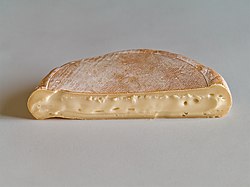Reblochon
| Reblochon | |
|---|---|
 |
|
| Country of origin | France |
| Region | Alps valley, Arly valley (Aravis Range) |
| Source of milk | Cows |
| Pasteurised | No |
| Texture | Soft washed-rind, smear-ripened |
| Fat content | 45% |
| Weight | 450 g (avg) |
| Aging time | 6-8 weeks |
| Certification | French AOC 1958 |
Reblochon (French pronunciation: [ʁə.blɔ.ʃɔ̃]) is a soft washed-rind and smear-ripenedFrench cheese made in the Alpine region of Savoy from raw cow's milk. It has its own AOC designation.
Reblochon was first produced in the Thônes and Arly valleys, in the Aravis massif. Thônes remains the centre of Reblochon production; the cheeses are still made in the local cooperatives. Until 1964 Reblochon was also produced in Italian areas of the Alps. Subsequently the Italian cheese has been sold in declining quantities under such names as Rebruchon and Reblò alpino.
Reblochon derives from the word "reblocher" which when literally translated means "to pinch a cow's udder again". This refers to the practice of holding back some of the milk from the first milking. During the 14th century, the landowners would tax the mountain farmers according to the amount of milk their herds produced. The farmers would therefore not fully milk the cows until after the landowner had measured the yield. The milk that remains is much richer, and was traditionally used by the dairymaids to make their own cheese.
In the 16th century the cheese also became known as "fromage de dévotion" (devotional cheese) because it was offered to the Carthusian monks of the Thônes Valley by the farmers, in return for having their homesteads blessed.
Raw-milk Reblochon has not been available in the United States since 2004 due to the enforcement of laws concerning the pasteurization of soft and semi-soft cheese.Delice du Jura, a pasteurized soft ripened cheese, is being marketed as a close relative and a good substitute in the United States.
Reblochon is a soft washed-rind and smear-ripenedcheese traditionally made from raw cow's milk. The cow breeds best for producing the milk needed for this cheese are the Abondance, Tarentaise and the Montbéliarde. This cheese measures 14 cm (5.5 in) across and 3–4 cm (1.2–1.6 in) thick, has a soft centre with a washed rind and weighs an average of 450 grams (16 oz). As proof of its being well-aged in an airy cellar, the rind of this cheese is covered with a fine white mould. The optimal period to savour this cheese is between May and September after it has been aged six to eight weeks. It is also excellent from March to December.
...
Wikipedia
